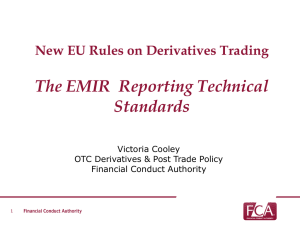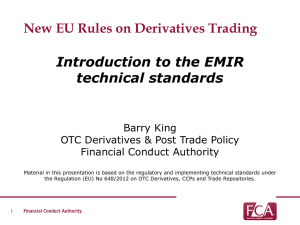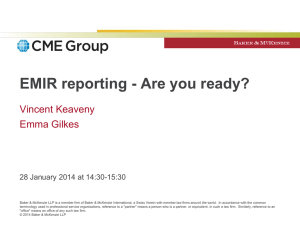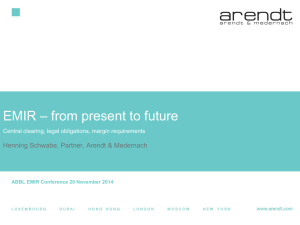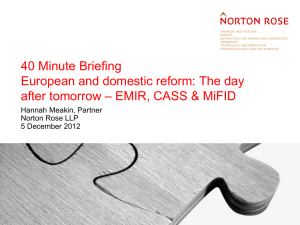European Market Infrastructure Regulation (“EMIR”)
advertisement
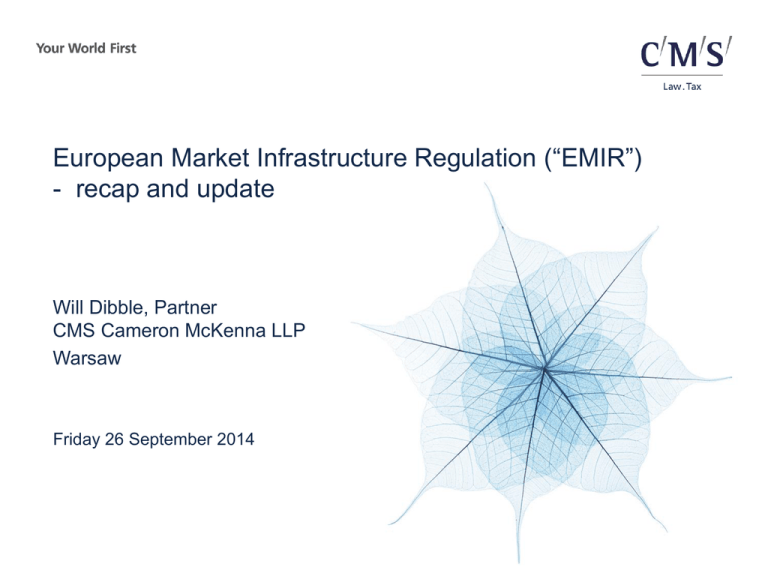
European Market Infrastructure Regulation (“EMIR”) - recap and update Will Dibble, Partner CMS Cameron McKenna LLP Warsaw Friday 26 September 2014 What is EMIR? - EU regulation on OTC derivatives, central counterparties and trade repositories - Effective as of 16 August 2012 in all member states, without the need for any national legislation - “Framework legislation” – detailed implementing rules contained in subordinate legislation (RTS) developed by the European Securities & Markets Authority (ESMA) Who is in scope? Financial counterparties (FCs): broadly, banks, investment firms, insurers/reinsurers, UCITS/UCITS managers, pension schemes, alternative investments funds (AIFs) managed by AIFMs, in each case authorised or registered in accordance with the relevant EU directive Non-financial counterparties (NFCs): all undertakings established in the EU which are not FCs; NFCs whose OTC derivatives exceed certain “clearing thresholds” are referred to as NFC+ Third country entities (TCEs) outside the EU may also be impacted Exempt: public bodies, EU central banks, pension funds Major EMIR requirements EMIR imposes four main obligations on EU derivatives market participants: • Obligation to notify competent authority immediately (= on the first day) if over clearing threshold • Mandatory clearing of certain types of OTC derivatives via a central counterparty (CCP) • Implementation of risk mitigation techniques in relation to any OTC derivatives that are not cleared, including arrangements for timely confirmation; portfolio reconciliation, portfolio compression and dispute resolution; daily valuation of outstanding derivative contracts; margining • Mandatory reporting of all derivatives (OTC and ETD) to an authorised trade repository (TR) EMIR - implementation timeline 20 days later 1st Clearing Obligation RTS in force 18 March 2014 First CCP authorised July 2015 1st Clearing Obligation Category 1 January 2018 1st Clearing Obligation Category 3 July 2016 1st Clearing Obligation Category 2 Mid-December 2014 1st Clearing Obligation RTS published in OJ Q1 Q2 Q3 Q4 2013 Q1 Q1 Q2 Q3 Q4 2014 Q2 Q3 15 March 2013 Confirmations Daily valuation NFC+ reporting 15 September 2013 Portfolio reconciliation Portfolio compression Dispute resolution Q4 Q1 Q1 Q2 Q3 Q4 2015 Q2 Q3 12 February/ 11 August 2014 Reporting to TRs Q4 Q1 Q1 Q2 Q3 Q4 2016 Q2 Q3 Q4 Q1 Q1 Q2 Q3 Q4 2017 Q2 Q3 Q4 Q1 Q1 2018 Q2 Q3 Q4 16 August 2015 End of transitional period for pension schemes 1 December 2015 Variation margin applies and phasein of initial margin starts Note: Assumes ESMA delivers 1st Clearing Obligation RTS to EC on 18 September 2014 in the form proposed for consultation, Commission endorses RTS without amendment in early November 2014 and Council/Parliament do not object to the RTS and do not extend their objection period. Q1 What is already live? 15 March 2013 • NFC+ notification (Art. 10 of EMIR): NFCs must immediately notify the competent authority if their (and their non-financial affiliates’) positions in OTC derivatives of the same asset class (excluding hedging positions) exceed/no longer exceed specified clearing thresholds in respect of such class • Timely confirmations (Art. 11(1) of EMIR): o OTC derivatives between in scope counterparties must be confirmed by T+1 for contracts between FCs/NFC+ and T+2 for contracts with an NFC (as of the effective date (i.e. 15 March 2013), phase-in period which expired on 31 August 2014) o FCs must have procedures for monthly reporting of unconfirmed transactions. • Daily valuation (Art. 11(2) of EMIR): FCs and NFC+ must carry out daily mark-tomarket or, where market conditions prevent this, mark-to-model valuation What is already live? (cont.) 15 September 2013 • Portfolio reconciliation (Art. 11(1) of EMIR): FCs and NFCs must agree processes for regular portfolio reconciliation with counterparties, in frequencies as follows: o FC/NFC+: each BD (where 500 or more contracts outstanding); weekly (where between 51 and 499 contracts outstanding during the week); quarterly (where 50 or less contracts outstanding during the quarter) o NFC-: quarterly (where more than 100 contracts outstanding during the quarter); annually (where 100 or less contracts outstanding) • Portfolio compression (Art. 11(1) of EMIR): FCs and NFCs must have processes to address portfolio compression opportunities • Dispute resolution (Art. 11(1) of EMIR): FCs and NFCs must agree procedures for identification, recording, monitoring and resolution of disputes and FCs must report on unresolved disputes What is already live? (cont.) 12 February 2014 / 11 August 2014 • Reporting to TRs (Art. 9 of EMIR): o When: Counterparties must report all their contracts (OTC and ETD) to a registered or recognised TR or to ESMA by T+1 o Delegation: Counterparties may delegate the reporting to a third party but retain responsibility for the reporting obligation o TRs: Six TRs authorised so far: DTCC, REGIS-TR, CME TR, KDPW, ICE TVEL, UnaVista o What needs to be reported: (1) Common Data, including main characteristics of the trade such as the type of derivative, underling, maturity, notional value, price and settlement data, economic terms and trade identifiers; (2) Counterparty Data, including counterparty classification, beneficiary information and legal entity identifiers of the parties; (3) Collateral and Valuation Data, FCs and NFC+ have to report the daily mark-to-market (or mark-to-model) value as well as the value of collateral posted What is already live? (cont.) o When did the reporting obligation start: 12 February 2014 for Common Data and Counterparty Data 12 August 2014 for Collateral and Valuation Data Contracts outstanding on 16 August 2012 and still outstanding on 12 February 2014 (the reporting start date) had to be reported within 90 days of the reporting start date and contracts entered into before, on or after 16 August 2012 but not outstanding on the reporting start date must be reported within 3 years of the reporting start date o LEI: Counterparties should obtain a global legal entity identifier (LEI) when available for the purpose of reporting Counterparty Data (by registering with a pre-LOU (Local Operating Unit), i.e. GMEI Utility What is already live? (cont.) Segregation and Portability • Following the authorisation of a CCP under EMIR, counterparties (both FCs and NFCs) will have to make a choice between different types of omnibus and individually segregated accounts at the CCP • Each counterparty is required to have notified their clearing broker of its account election with respect to a CCP on which it currently clears or wishes to clear • Counterparties can change elections at any point in time Future stages of the EMIR implementation TCE – TCE transactions 10 April 2014 / 10 October 2014 TCEs may be subject to certain EMIR requirements, namely clearing and risk mitigation, in the following circumstances: Direct impact • The clearing obligation will apply directly to certain TCEs (= those that would be subject to the clearing obligation if it were established in the EU) when they enter into OTC derivative contracts with FCs/NFCs+ • ESMA has issued RTS for directly extending EMIR clearing and risk mitigation obligations to OTC derivatives between two TCEs where: o the contract has a direct, substantial and foreseeable effect within the EU; or o it is necessary to prevent evasion of the EMIR rules Future stages of the EMIR implementation TCE – TCE transactions (cont.) • A contract will have a direct, substantial and foreseeable effect within the EU where: o at least one TCE benefits from a guarantee of an EU FC and certain quantitative thresholds are met with respect to that guarantee; or o the contract is between EU branches of TCEs where the TCEs would qualify as FCs if they were established in the EU TCEs are encouraged to tell their counterparties if they have an EU FC guarantor Future stages of the EMIR implementation TCE – TCE transactions (cont.) Quantitative Threshold 1 Guarantee covers: • the entire liability of a TCE resulting from one or more OTC derivative contracts for an aggregated notional amount of at least EUR 8bn (or foreign currency equivalent); or • a part of the liability of a TCE resulting from one or more OTC derivative contracts for an aggregated notional amount of at least EUR 8bn (or foreign currency equivalent) divided by the percentage of the liability covered Quantitative Threshold 2 Liability covered is at least equal to 5 per cent. of the sum of the EU FC guarantor’s current exposures in OTC derivative contracts Issues: (i) single guarantee test / multiple guarantee test; (ii) ongoing assessment of the thresholds Future stages of the EMIR implementation TCE – TCE transactions (cont.) Indirect impact • EMIR can indirectly impact TCEs when they enter into derivatives with EU counterparties »»» any such counterparty will only be able to enter into a derivative on terms which enable it to comply with its EMIR obligations EMIR envisages equivalence assessments by the Commission of non-EU jurisdictions: • for the purpose of determining exemptions from conflicting and/or duplicative clearing, reporting and risk mitigation obligations; and • as part of the recognition process for non-EU CCPs and non-EU TRs Future stages of the EMIR implementation Margining of uncleared OTC derivatives - Article 11(3) of EMIR - FCs and NFC+s - On 14 April 2014, the ESAs published a consultation paper on margin for uncleared OTC derivatives (comment period closed 14 July 2014), proposing a start date of 1 December 2015 for margining, subject to phase-in of initial margin requirements - ESAs expected to deliver final draft RTS to the Commission by end 2014 Future stages of the EMIR implementation Margining of uncleared OTC derivatives (cont.) - Draft RTS – overview • Applicable prospectively • 5 Chapters: o Counterparties’ risk management procedures o Margin methods o Eligibility and treatment of collateral o Operational procedures o Procedures concerning intragroup derivative contracts Future stages of the EMIR implementation Margining of uncleared OTC derivatives (cont.) - Risk management procedures – general • the collection of collateral – Initial Margin (IM) Collected “to cover potential future exposure to the other counterparty providing the margin in the interval between the last margin collection and the liquidation of positions following a default of the other counterparty” → on gross basis (ie, without the possibility of netting IM amounts between each other) • the collection of collateral – Variation Margin (VM) Collected “to reflect current exposures resulting from actual changes in market price” → on net basis • an upfront agreement on a list of eligible collateral Future stages of the EMIR implementation Margining of uncleared OTC derivatives (cont.) - IM • Phased in from 1 December 2015 • Must be collected within the BD following the execution of a new derivative contract • The total amount of IM collected from another counterparty must be recalculated and collected, amongst others, when: o a new contract is executed with that counterparty o an existing contract with that counterparty expires o an existing contract triggers a payment (or delivery) other than posting or collecting VM o no IM recalculation has been performed in the last 10 BDs Future stages of the EMIR implementation Margining of uncleared OTC derivatives (cont.) Phase-in timetable for IM From 1 December Trigger level for consolidated groups 2015 €3 trillion 2016 €2.25 trillion 2017 €1.5 trillion 2018 €0.75 trillion 2019 onwards €8 billion Future stages of the EMIR implementation Margining of uncleared OTC derivatives (cont.) - VM • Effective as from 1 December 2015 • Must be collected at least on a daily basis starting from the BD following the execution of the contract • Based on the current valuation of each derivative contract calculated in accordance with Art. 11(2) of EMIR and Arts. 16 and 17 of RTS Future stages of the EMIR implementation Margining of uncleared OTC derivatives (cont.) - Risk management procedures – specific • Counterparties may agree not to collect IM with respect to: o physically settled foreign exchange forwards and swaps o exchange of principal of a currency swap • FCs may agree with their FC or NFC counterparties on a margin threshold of €50m covering all IM to be exchanged between consolidated groups – on the condition that capital be held against a party’s exposure to its counterparty Counterparties may reduce the amount of IM exchanged by the value of the threshold Future stages of the EMIR implementation Margining of uncleared OTC derivatives (cont.) - Risk management procedures – specific (cont.) • Counterparties may agree a minimum transfer amount of €500,000 covering all IM and VM and excess collateral (if any) • FCs/NFC+s may agree not to collect IM or VM from NFC-s and/or counterparties exempt from EMIR • Counterparties may agree that IM and VM are not posted by covered bond issuers and cover pools if certain conditions are met, including: o derivative must not terminate in case of default of the covered bond issuer o legal over collateralisation of at least 102% o derivative used only for hedging purposes Future stages of the EMIR implementation Margining of uncleared OTC derivatives (cont.) Margin methods Margin methods Standardised method Initial margin models • Annex IV of the draft RTS • • Notional amounts or underlying values of the derivative contracts be multiplied by the relevant percentages – dependant, essentially, upon residual maturity • • May be developed by a counterparty or jointly by the two counterparties or by a third party agent No industry-wide modelling common approach Counterparties must notify the relevant competent authorities if they are intending to use an initial margin model Future stages of the EMIR implementation Margining of uncleared OTC derivatives (cont.) - Initial margin models - requirements: • Calibration of the model o Based on historical data from a period of at least three years o At least 25% of stressed data o Recalibration at least every 6 months • Primary risk factor and underlying classes o IM to be calculated first at underlying class level o Total IM = sum of IM calculated for each underlying class • Assessments of the validity of the model’s risk assessments o Initial validation by independent parties o At least annually o A process for verifying at least annually that the netting agreements considered for IM calculation are legally enforceable o Clear documentation showing all changes to the initial margin model and the tests performed Future stages of the EMIR implementation Margining of uncleared OTC derivatives (cont.) - Eligibility and treatment of collateral • Asset classes as listed in the draft RTS – cash; gold; debt securities issued by central governments, central banks, public sector entities, credit institutions, investment firms; corporate bonds; equities; shares or units in UCITS • Requirement for credit quality assessment in relation to certain asset classes using one of the methodologies specified in the draft RTS: o IRB (if authorised) o ECAI • Specific eligibility criteria apply to certain asset classes Future stages of the EMIR implementation Margining of uncleared OTC derivatives (cont.) - Eligibility and treatment of collateral (cont.) • Concentration limits for IM and VM o No limits applicable to cash o 50%; 10%; 40% • Haircuts o standard methodology in Annex II (0.5% – 24%, depending in particular upon the residual maturity and the type of securities) o own estimates subject to criteria in Annex III Future stages of the EMIR implementation Margining of uncleared OTC derivatives (cont.) - Operational procedures • Exchange of collateral: o a detailed documentation of policy (covering collateral levels, types and eligibility, applicable haircuts) – updated at least annually o processes for escalation with counterparties o counterparties must agree in writing the terms of the operational process for the exchange of collateral (including any segregation arrangements, settlement of margin calls, methods for calculating and valuing collateral etc.) o procedures to periodically verify the liquidity of the eligible collateral • Segregation of IM • No ability to re-hypothecate, re-pledge or otherwise re-use IM Future stages of the EMIR implementation Margining of uncleared OTC derivatives (cont.) - Procedures concerning intragroup derivative contracts • Intragroup risk management procedures must ensure the regular monitoring of the intragroup exposures and the timely settlement of the obligations arising out of the intragroup OTC derivatives • No current or foreseen practical or legal impediment to the prompt transfer of own funds or repayment of liabilities between the counterparties, that is: o sufficient assets available to satisfy transfers or repayments when due (no operational obstacles etc.) o no restrictions under the applicable laws or any relevant contractual relationships (the absence of currency or exchange controls, regulatory restrictions, limitation on the ability to transfer funds etc.) Future stages of the EMIR implementation Clearing obligation Article 4 of EMIR Certain OTC derivatives that has been declared subject to the clearing obligation entered into between certain market participants will have to be cleared Two parties to an OTC derivative contract replace it with two separate contracts with a central counterparty (CCP) which takes each party’s positions under the original contract Obligation applies to any combination FCs and NFC+s (including a TCE), provided one or more of the parties is established in the EU NFC is an NFC+ if over 30 working days exceeds any of the clearing thresholds in any derivatives asset class (other than hedging derivatives) List of CCPs that have been authorised to offer services and activities in the Union as at 23 September 2014 No Name of the CCP Country of establishment Competent authority (if established in the Union) Date of authorisation 1. Nasdaq OMX Clearing AB Sweden Finansinpektionen 18 March 2014 2. European Central Counterparty N.V. Netherlands De Nederlandsche Bank (DNB) 1 April 2014 3. KDPW_CCP Poland Komsija Nadzoru Finansowego (KNF) 8 April 2014 4. Eurex Clearing AG Germany Bundesanstalt für Finanzdienstleistungs aufsicht (Bafin) 10 April 2014 5. Cassa di Compensazione e Garanzia S.p.A. (CCG) Italy Banca d’Italia 20 Mary 2014 6. LCH.Clearnet SA France Autorité de Contrôle Prudentiel et de Résolution (ACPR) 22 May 2014 7. European Commodity Clearing Germany Bundesanstalt für Finanzdienstleistungs aufsicht (Bafin) 11 June 2014 8. LCH.Clearnet Ltd United Kingdom Bank of England 12 June 2014 9. Keler CCP Hungary Central Bank of Hungary (MNB) 4 July 2014 10. CME Clearing Europe Ltd United Kingdom Bank of England 4 August 2014 11. CCP Austria Abwicklungsstelle für Börsengeschäfte GmbH (CCP.A) Austria Austrian Financial Market Authority (FMA) 14 September 2014 12. LME Clear Ltd United Kingdom Bank of England 3 September 2014 13. BME Clearing Spain Comisión Nacional del Mercado de Valores (CNMV) 16 September 2014 30 Future stages of the EMIR implementation Clearing - obligation (cont.) Hedging derivatives excluded in determining NFC category: • “objectively measurable as reducing risks directly relating to the commercial activities or treasury financing activities of the NFC or of the group” • only needs to constitute a hedge at time of entry into transaction Exemptions apply for intragroup transactions, OTC derivative contracts associated with covered bond programmes and pension funds until August 2015 Future stages of the EMIR implementation Clearing - obligation (cont.) ESMA is required to draft RTS on the clearing obligation within six months of the authorisation of the CCPs ESMA published two consultation papers on 11 July 2014 (comment periods closed 18 August 2014 and 18 September 2014) ESMA was expected to publish first draft RTS by 18 September 2014. The EC then has 3 months to determine whether to endorse, endorse with amendments or not endorse the RTS If endorsed, the RTS will come into force 20 days after publication in the Official Journal (i.e. Jan 2015). However, the consultation papers have indicated a phased-in approach ESMA has taken a ‘Bottom-up’ approach. The determination of those classes which will be subject to the clearing obligation is based upon the classes which are already cleared by authorised CCPs Future stages of the EMIR implementation Clearing - obligation (cont.) Consultation No.1 - Interest rate OTC derivative classes – in-scope • Type: Fixed-to-float interest rate swaps, float-to-float swaps (basis swaps), forward rate agreements, overnight index swaps • Central Counterparties: Nasdaq OMX (Sweden), Eurex (Germany), KDPW_CCP (Poland) and LCH.Clearnet Limited (UK) - Equity and interest rate futures and options classes - out-of scope • interest rate future and option classes cleared by LCH.Clearnet Limited (UK) and Nasdaq OMX (Sweden) • Interest rate OTC derivative classes cleared by KDPW_CCP (Poland) (only authorised for IRS denominated in PLN and not covered ) • Equity OTC derivative classes cleared by Nasdaq OMX (Sweden) and LCH.Clearnet Limited (UK) Future stages of the EMIR implementation Clearing - obligation (cont.) Consultation No.2 Credit default swaps – in-scope • Type: untranched index credit default swaps • Central Counterparties: LCH.Clearnet SA (France) (with ICE Clear Europe expected to be authorised by the time the RTS enters into force) Single name credit default swaps cleared by Nasdaq OMX (Sweden) and LCH.Clearnet SA (France) – out of scope Future stages of the EMIR implementation Clearing - obligation (cont.) Proposed timetable Category 1 – Clearing members – 6-month phase-in period after entry into RTS Entities which are, at the date the relevant RTS comes into force: • clearing members of at least one CCP (such CCP having been authorised to clear the class of derivatives which are subject to the RTS); and • their clearing membership allows it to clear the relevant class of derivatives Category 2 – Non-clearing members – 18-month phase-in period after entry into RTS Counterparties not falling in Category 1 or Category 3. This will include (i) FCs not in Category 1 and (ii) AIFs qualifying as NFC+ not included in Category 1 Category 3 – NFC+ – 3-year phase-in period after entry into RTS NFC+ not included in Category 1 or 2 Where a contract is entered into with counterparties in different categories, the date the clearing obligation will take effect is the later of the two Future stages of the EMIR implementation Clearing - frontloading Does not apply to contracts if at least one party is a NFC Frontloading can be split into two different timeframes: • Period A – between the notification of the classes to ESMA and the publication in the OJ of the RTS on the clearing obligation • Period B – between the publication in the OJ of the RTS and the date on which the clearing obligation takes effect Different minimum remaining maturity (MRM) periods: • Period A – MRM is set at the maximum maturity of the contracts per class minus the length of the implementation period. Therefore, no contracts in Period A will be subject to the frontloading obligation • Period B – MRM is set at 6 months (i.e. those contracts which are close to expiration on the date of application of the clearing obligation are not required to be cleared) Expected developments Commission to report on progress on the transfer by pension scheme arrangements of on-cash collateral as variation margin and whether the exemption from the clearing obligation for pension scheme arrangements will be extended under Art.82(2) EMIR (17 August 2014) Expiry of compliance schedule for confirmations of uncleared OTC derivatives (31 August 2014), T+1 or T+2 deadline fully applicable Q3 2014 ESMA to deliver first draft clearing obligation RTS to the Commission by 18 September 2014, with other draft RTS to follow by 12 December 2014 ESMA to publish reports under Art.85(3) EMIR by 30 September 2014 (preparatory to Commission’s general report on EMIR) Commission expected to publish first equivalence assessments under Art.25 EMIR (and possibly also under Art.13 EMIR) Expected authorisation of additional EU CCPs and first recognitions of non-EU CCPs, triggering additional consultations on clearing obligations Possible ESMA Q&A on how obligations apply to TCE-TCE trades before 10 October 2014 (start date under RTS on TCE-TCE trades) Deadline for comments on the ESMA DP on calculation of counterparty risk by UCITS for cleared OTC derivative transactions (22 October 2014) Q4 2014 Possible amendment of the CRR to extend the transitional capital relief for exposures to qualifying CCPs before 15 December 2014 Expected publication of the first clearing obligation RTS in the OJ in mid-December 2014 ESAs expected to deliver the draft margin RTS to the Commission by the end of Q4 2014 Possible ESMA consultation on guidelines on the definition of spot foreign exchange under MiFID Q1 2015 Commission to publish annual report on possible systemic risks and cost implications of interoperability arrangements pursuant to Art.85(4) EMIR ESMA to present annual report on penalties imposed by NCAs pursuant to Art.85(5) EMIR Expected publication of the margin RTS in the OJ in early Q2 2015 Q2 2015 Additional third country central banks expected to be added to the list of exempted entities in Art.1(4) EMIR (before first clearing obligation effective) NCAs expected to start accepting applications for the intra-group exemption to the clearing obligation (before first clearing obligation effective) Q3 2015 2017 Commission to publish general report on EMIR implementation pursuant to Art. 85(1) EMIR by 17 August 2014 ESMA to list pension arrangements specifically exempted from the clearing obligation by NCAs (before first clearing obligation effect for NFC+) Deadline for reporting to TRs pre-existing contracts that were not outstanding on the reporting start date (12 February 2017) Any questions?
